Risk Management Plan: Western Australia Rail Project Analysis
VerifiedAdded on 2023/01/19
|18
|4219
|32
Report
AI Summary
This report presents a comprehensive risk management plan for the Western Australia rail project, drawing insights from the NSW Regional Rail Fleet project. It begins with an introduction outlining the project's context and objectives, followed by a discussion of potential risk treatments and responses, including avoid, mitigate, transfer, accept, share, contingency, enhance, exploit, and reject strategies. The core of the report details a risk management plan, including a summary of both negative and positive risks, along with their corresponding mitigation strategies. A detailed risk assessment matrix is provided, identifying specific risks, their impact, likelihood, risk scores, and mitigation plans. The report concludes with recommendations based on the analysis and a final conclusion summarizing the key findings and implications for the Western Australia rail project's success. The report utilizes various sources such as journal papers, webpage articles, PMBOK guide and the NSW government website for information.
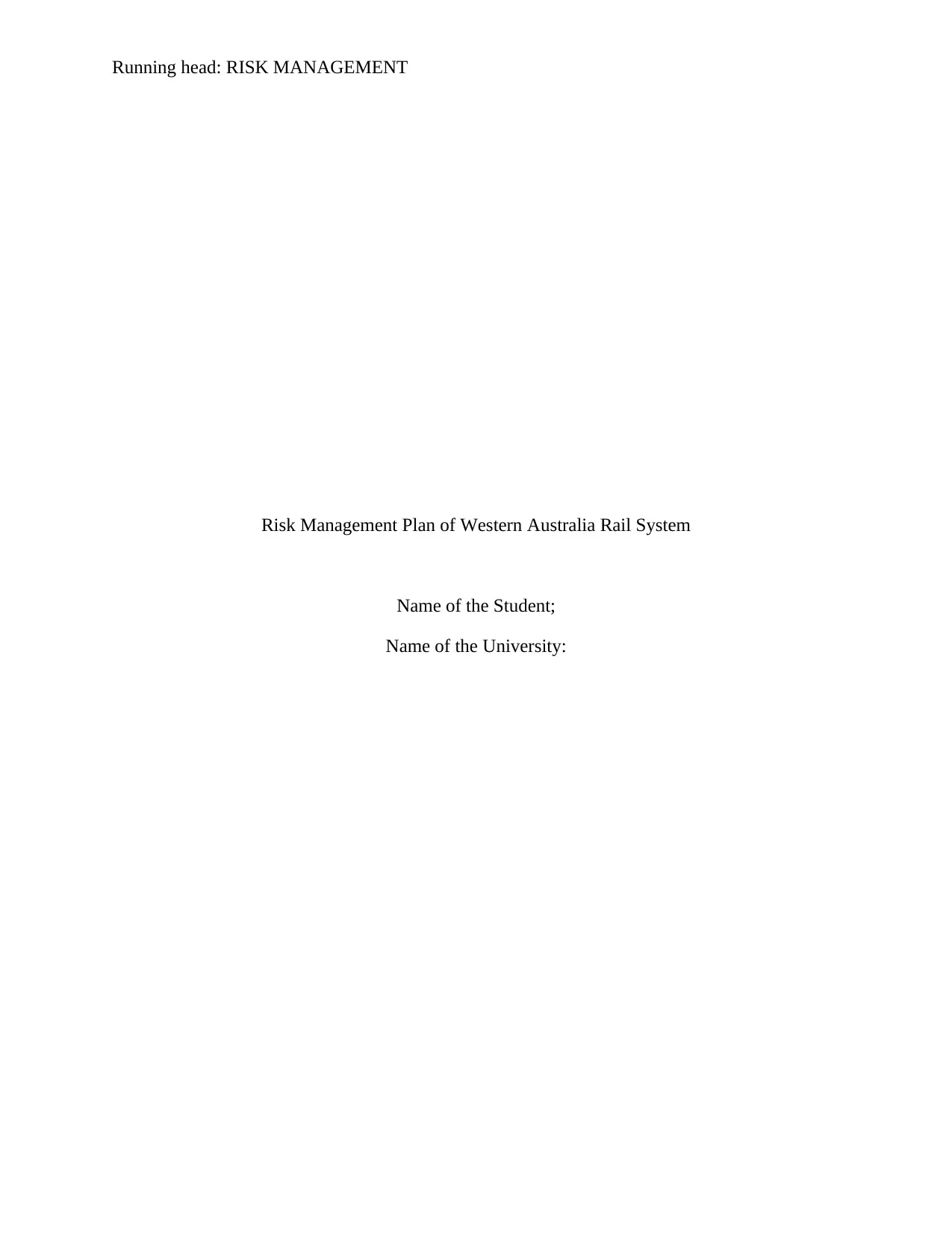
Running head: RISK MANAGEMENT
Risk Management Plan of Western Australia Rail System
Name of the Student;
Name of the University:
Risk Management Plan of Western Australia Rail System
Name of the Student;
Name of the University:
Paraphrase This Document
Need a fresh take? Get an instant paraphrase of this document with our AI Paraphraser
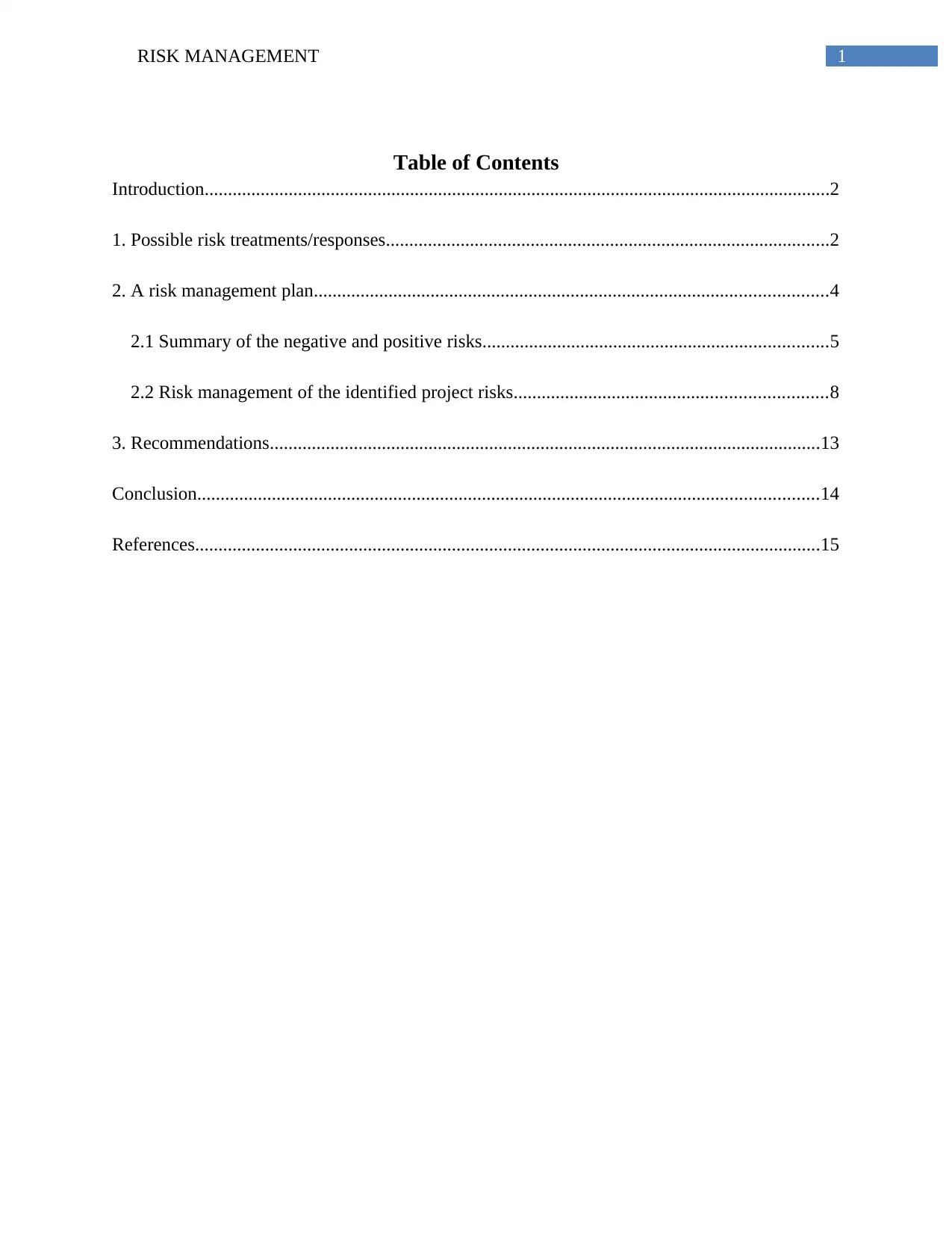
1RISK MANAGEMENT
Table of Contents
Introduction......................................................................................................................................2
1. Possible risk treatments/responses...............................................................................................2
2. A risk management plan..............................................................................................................4
2.1 Summary of the negative and positive risks..........................................................................5
2.2 Risk management of the identified project risks...................................................................8
3. Recommendations......................................................................................................................13
Conclusion.....................................................................................................................................14
References......................................................................................................................................15
Table of Contents
Introduction......................................................................................................................................2
1. Possible risk treatments/responses...............................................................................................2
2. A risk management plan..............................................................................................................4
2.1 Summary of the negative and positive risks..........................................................................5
2.2 Risk management of the identified project risks...................................................................8
3. Recommendations......................................................................................................................13
Conclusion.....................................................................................................................................14
References......................................................................................................................................15
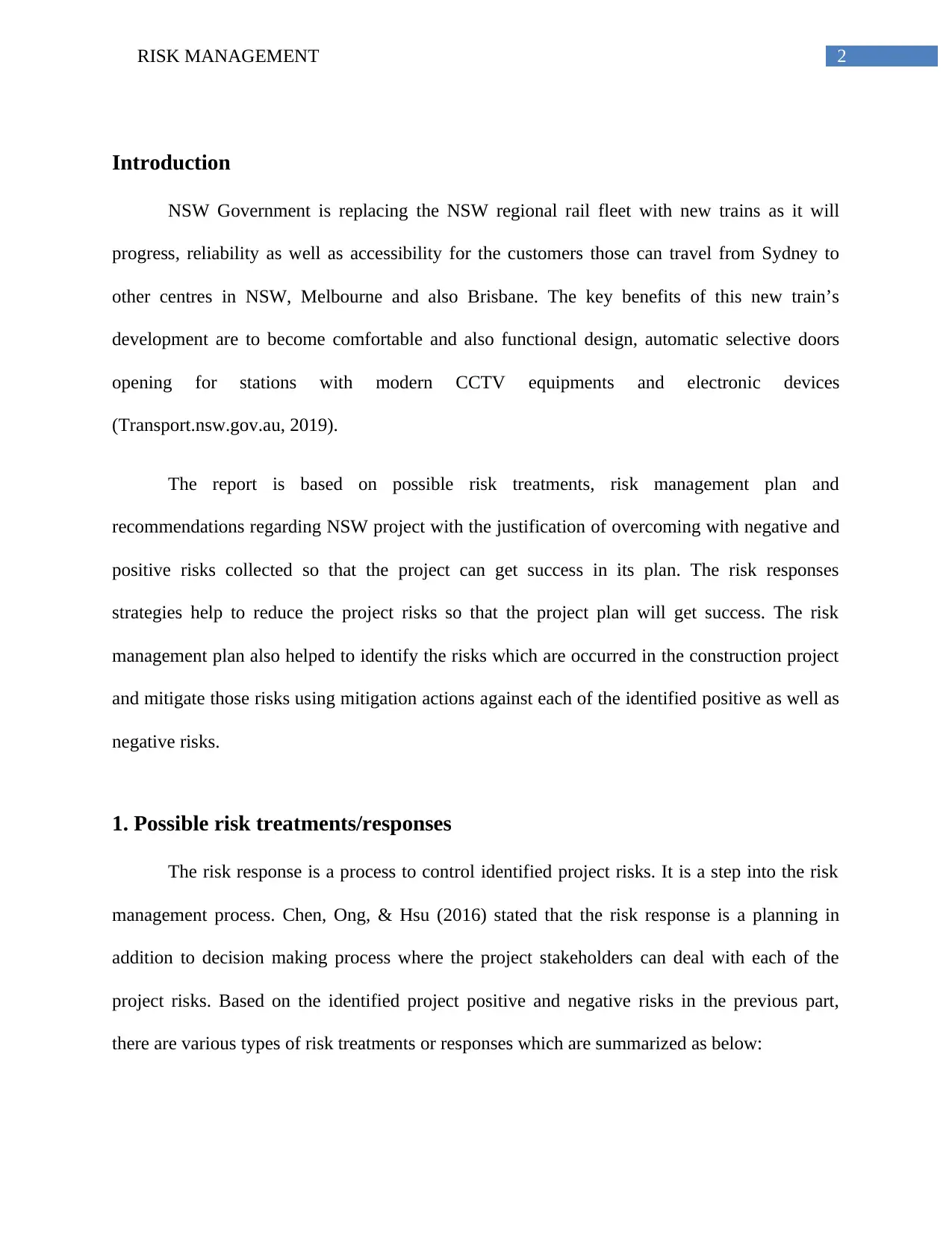
2RISK MANAGEMENT
Introduction
NSW Government is replacing the NSW regional rail fleet with new trains as it will
progress, reliability as well as accessibility for the customers those can travel from Sydney to
other centres in NSW, Melbourne and also Brisbane. The key benefits of this new train’s
development are to become comfortable and also functional design, automatic selective doors
opening for stations with modern CCTV equipments and electronic devices
(Transport.nsw.gov.au, 2019).
The report is based on possible risk treatments, risk management plan and
recommendations regarding NSW project with the justification of overcoming with negative and
positive risks collected so that the project can get success in its plan. The risk responses
strategies help to reduce the project risks so that the project plan will get success. The risk
management plan also helped to identify the risks which are occurred in the construction project
and mitigate those risks using mitigation actions against each of the identified positive as well as
negative risks.
1. Possible risk treatments/responses
The risk response is a process to control identified project risks. It is a step into the risk
management process. Chen, Ong, & Hsu (2016) stated that the risk response is a planning in
addition to decision making process where the project stakeholders can deal with each of the
project risks. Based on the identified project positive and negative risks in the previous part,
there are various types of risk treatments or responses which are summarized as below:
Introduction
NSW Government is replacing the NSW regional rail fleet with new trains as it will
progress, reliability as well as accessibility for the customers those can travel from Sydney to
other centres in NSW, Melbourne and also Brisbane. The key benefits of this new train’s
development are to become comfortable and also functional design, automatic selective doors
opening for stations with modern CCTV equipments and electronic devices
(Transport.nsw.gov.au, 2019).
The report is based on possible risk treatments, risk management plan and
recommendations regarding NSW project with the justification of overcoming with negative and
positive risks collected so that the project can get success in its plan. The risk responses
strategies help to reduce the project risks so that the project plan will get success. The risk
management plan also helped to identify the risks which are occurred in the construction project
and mitigate those risks using mitigation actions against each of the identified positive as well as
negative risks.
1. Possible risk treatments/responses
The risk response is a process to control identified project risks. It is a step into the risk
management process. Chen, Ong, & Hsu (2016) stated that the risk response is a planning in
addition to decision making process where the project stakeholders can deal with each of the
project risks. Based on the identified project positive and negative risks in the previous part,
there are various types of risk treatments or responses which are summarized as below:
⊘ This is a preview!⊘
Do you want full access?
Subscribe today to unlock all pages.

Trusted by 1+ million students worldwide
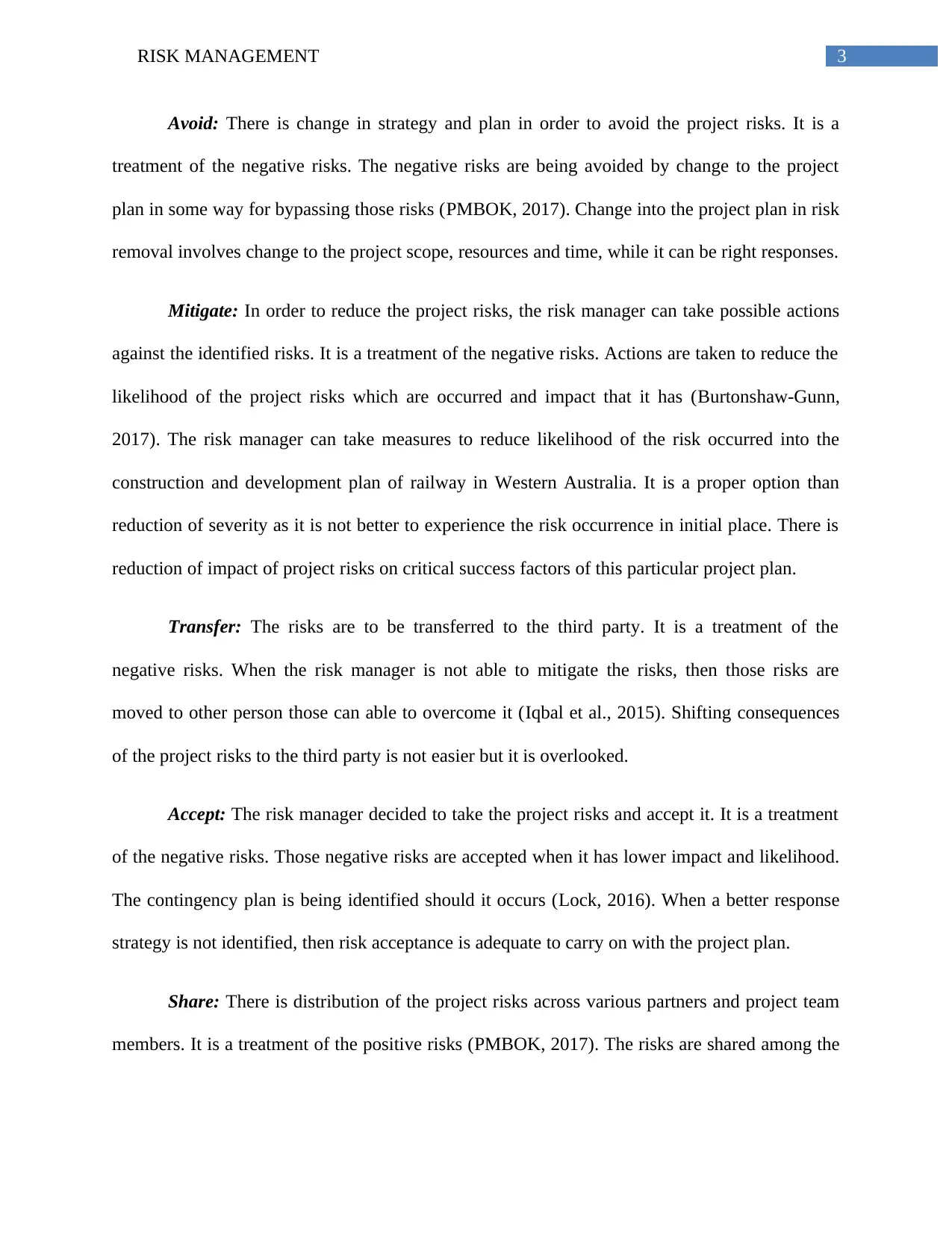
3RISK MANAGEMENT
Avoid: There is change in strategy and plan in order to avoid the project risks. It is a
treatment of the negative risks. The negative risks are being avoided by change to the project
plan in some way for bypassing those risks (PMBOK, 2017). Change into the project plan in risk
removal involves change to the project scope, resources and time, while it can be right responses.
Mitigate: In order to reduce the project risks, the risk manager can take possible actions
against the identified risks. It is a treatment of the negative risks. Actions are taken to reduce the
likelihood of the project risks which are occurred and impact that it has (Burtonshaw-Gunn,
2017). The risk manager can take measures to reduce likelihood of the risk occurred into the
construction and development plan of railway in Western Australia. It is a proper option than
reduction of severity as it is not better to experience the risk occurrence in initial place. There is
reduction of impact of project risks on critical success factors of this particular project plan.
Transfer: The risks are to be transferred to the third party. It is a treatment of the
negative risks. When the risk manager is not able to mitigate the risks, then those risks are
moved to other person those can able to overcome it (Iqbal et al., 2015). Shifting consequences
of the project risks to the third party is not easier but it is overlooked.
Accept: The risk manager decided to take the project risks and accept it. It is a treatment
of the negative risks. Those negative risks are accepted when it has lower impact and likelihood.
The contingency plan is being identified should it occurs (Lock, 2016). When a better response
strategy is not identified, then risk acceptance is adequate to carry on with the project plan.
Share: There is distribution of the project risks across various partners and project team
members. It is a treatment of the positive risks (PMBOK, 2017). The risks are shared among the
Avoid: There is change in strategy and plan in order to avoid the project risks. It is a
treatment of the negative risks. The negative risks are being avoided by change to the project
plan in some way for bypassing those risks (PMBOK, 2017). Change into the project plan in risk
removal involves change to the project scope, resources and time, while it can be right responses.
Mitigate: In order to reduce the project risks, the risk manager can take possible actions
against the identified risks. It is a treatment of the negative risks. Actions are taken to reduce the
likelihood of the project risks which are occurred and impact that it has (Burtonshaw-Gunn,
2017). The risk manager can take measures to reduce likelihood of the risk occurred into the
construction and development plan of railway in Western Australia. It is a proper option than
reduction of severity as it is not better to experience the risk occurrence in initial place. There is
reduction of impact of project risks on critical success factors of this particular project plan.
Transfer: The risks are to be transferred to the third party. It is a treatment of the
negative risks. When the risk manager is not able to mitigate the risks, then those risks are
moved to other person those can able to overcome it (Iqbal et al., 2015). Shifting consequences
of the project risks to the third party is not easier but it is overlooked.
Accept: The risk manager decided to take the project risks and accept it. It is a treatment
of the negative risks. Those negative risks are accepted when it has lower impact and likelihood.
The contingency plan is being identified should it occurs (Lock, 2016). When a better response
strategy is not identified, then risk acceptance is adequate to carry on with the project plan.
Share: There is distribution of the project risks across various partners and project team
members. It is a treatment of the positive risks (PMBOK, 2017). The risks are shared among the
Paraphrase This Document
Need a fresh take? Get an instant paraphrase of this document with our AI Paraphraser
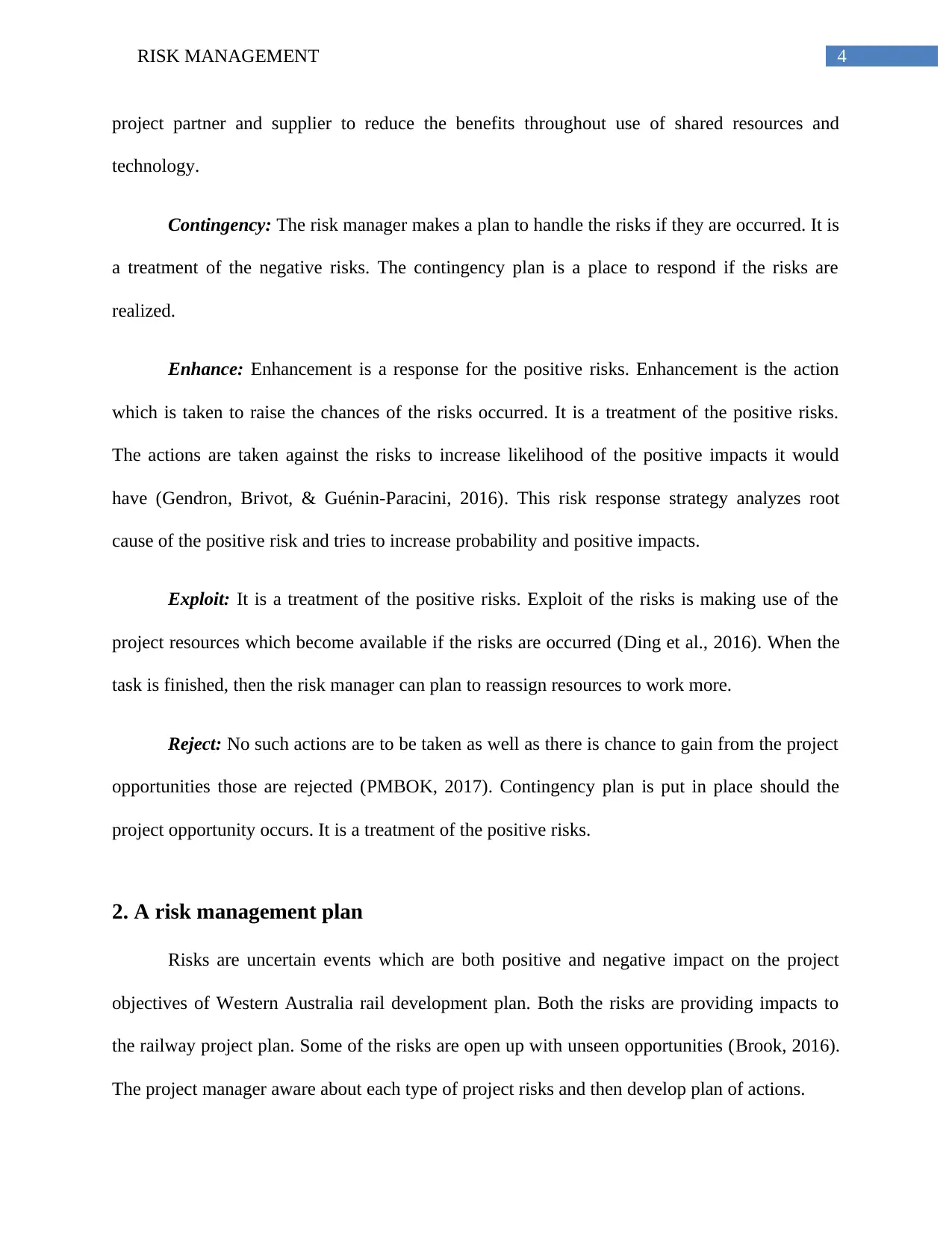
4RISK MANAGEMENT
project partner and supplier to reduce the benefits throughout use of shared resources and
technology.
Contingency: The risk manager makes a plan to handle the risks if they are occurred. It is
a treatment of the negative risks. The contingency plan is a place to respond if the risks are
realized.
Enhance: Enhancement is a response for the positive risks. Enhancement is the action
which is taken to raise the chances of the risks occurred. It is a treatment of the positive risks.
The actions are taken against the risks to increase likelihood of the positive impacts it would
have (Gendron, Brivot, & Guénin-Paracini, 2016). This risk response strategy analyzes root
cause of the positive risk and tries to increase probability and positive impacts.
Exploit: It is a treatment of the positive risks. Exploit of the risks is making use of the
project resources which become available if the risks are occurred (Ding et al., 2016). When the
task is finished, then the risk manager can plan to reassign resources to work more.
Reject: No such actions are to be taken as well as there is chance to gain from the project
opportunities those are rejected (PMBOK, 2017). Contingency plan is put in place should the
project opportunity occurs. It is a treatment of the positive risks.
2. A risk management plan
Risks are uncertain events which are both positive and negative impact on the project
objectives of Western Australia rail development plan. Both the risks are providing impacts to
the railway project plan. Some of the risks are open up with unseen opportunities (Brook, 2016).
The project manager aware about each type of project risks and then develop plan of actions.
project partner and supplier to reduce the benefits throughout use of shared resources and
technology.
Contingency: The risk manager makes a plan to handle the risks if they are occurred. It is
a treatment of the negative risks. The contingency plan is a place to respond if the risks are
realized.
Enhance: Enhancement is a response for the positive risks. Enhancement is the action
which is taken to raise the chances of the risks occurred. It is a treatment of the positive risks.
The actions are taken against the risks to increase likelihood of the positive impacts it would
have (Gendron, Brivot, & Guénin-Paracini, 2016). This risk response strategy analyzes root
cause of the positive risk and tries to increase probability and positive impacts.
Exploit: It is a treatment of the positive risks. Exploit of the risks is making use of the
project resources which become available if the risks are occurred (Ding et al., 2016). When the
task is finished, then the risk manager can plan to reassign resources to work more.
Reject: No such actions are to be taken as well as there is chance to gain from the project
opportunities those are rejected (PMBOK, 2017). Contingency plan is put in place should the
project opportunity occurs. It is a treatment of the positive risks.
2. A risk management plan
Risks are uncertain events which are both positive and negative impact on the project
objectives of Western Australia rail development plan. Both the risks are providing impacts to
the railway project plan. Some of the risks are open up with unseen opportunities (Brook, 2016).
The project manager aware about each type of project risks and then develop plan of actions.
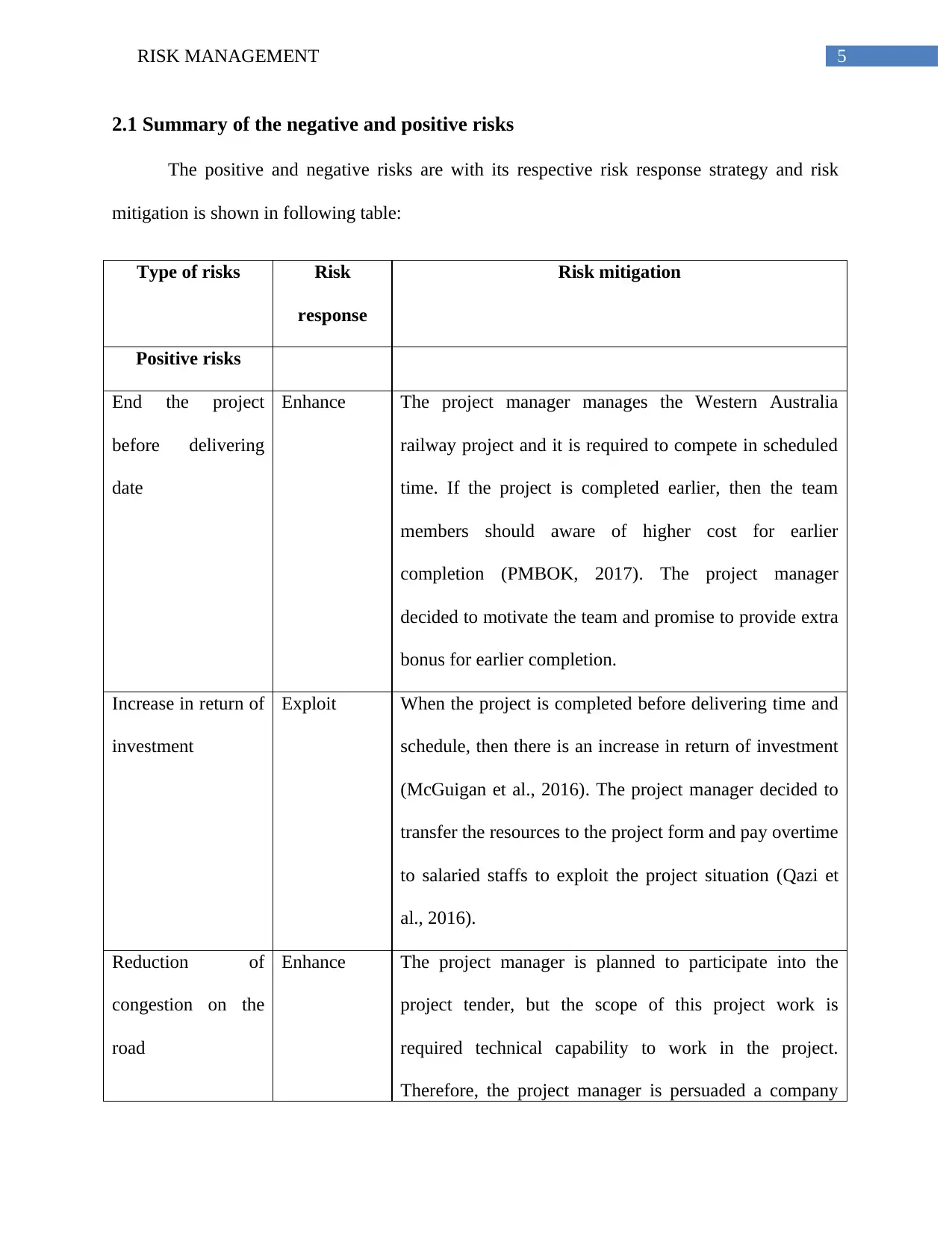
5RISK MANAGEMENT
2.1 Summary of the negative and positive risks
The positive and negative risks are with its respective risk response strategy and risk
mitigation is shown in following table:
Type of risks Risk
response
Risk mitigation
Positive risks
End the project
before delivering
date
Enhance The project manager manages the Western Australia
railway project and it is required to compete in scheduled
time. If the project is completed earlier, then the team
members should aware of higher cost for earlier
completion (PMBOK, 2017). The project manager
decided to motivate the team and promise to provide extra
bonus for earlier completion.
Increase in return of
investment
Exploit When the project is completed before delivering time and
schedule, then there is an increase in return of investment
(McGuigan et al., 2016). The project manager decided to
transfer the resources to the project form and pay overtime
to salaried staffs to exploit the project situation (Qazi et
al., 2016).
Reduction of
congestion on the
road
Enhance The project manager is planned to participate into the
project tender, but the scope of this project work is
required technical capability to work in the project.
Therefore, the project manager is persuaded a company
2.1 Summary of the negative and positive risks
The positive and negative risks are with its respective risk response strategy and risk
mitigation is shown in following table:
Type of risks Risk
response
Risk mitigation
Positive risks
End the project
before delivering
date
Enhance The project manager manages the Western Australia
railway project and it is required to compete in scheduled
time. If the project is completed earlier, then the team
members should aware of higher cost for earlier
completion (PMBOK, 2017). The project manager
decided to motivate the team and promise to provide extra
bonus for earlier completion.
Increase in return of
investment
Exploit When the project is completed before delivering time and
schedule, then there is an increase in return of investment
(McGuigan et al., 2016). The project manager decided to
transfer the resources to the project form and pay overtime
to salaried staffs to exploit the project situation (Qazi et
al., 2016).
Reduction of
congestion on the
road
Enhance The project manager is planned to participate into the
project tender, but the scope of this project work is
required technical capability to work in the project.
Therefore, the project manager is persuaded a company
⊘ This is a preview!⊘
Do you want full access?
Subscribe today to unlock all pages.

Trusted by 1+ million students worldwide
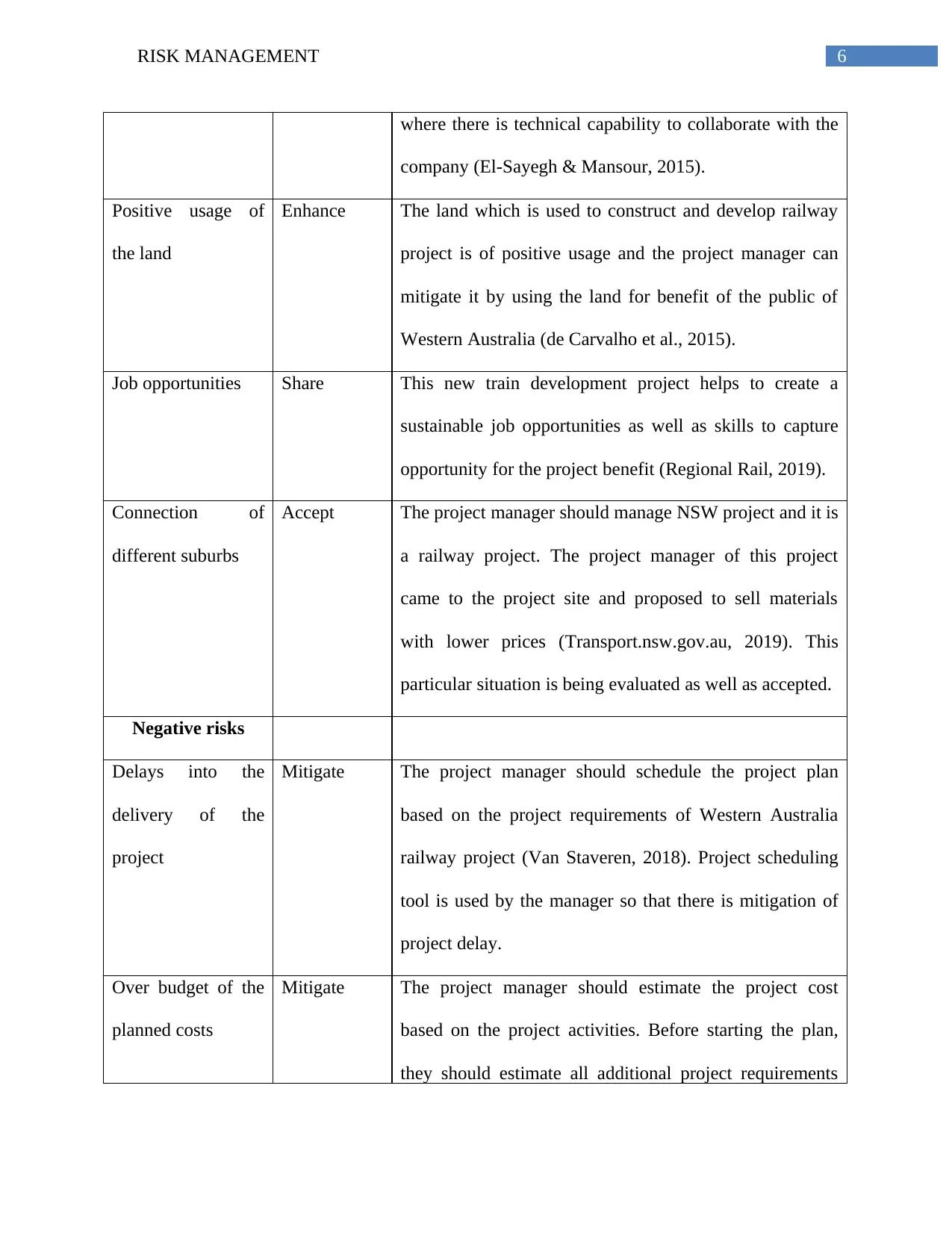
6RISK MANAGEMENT
where there is technical capability to collaborate with the
company (El-Sayegh & Mansour, 2015).
Positive usage of
the land
Enhance The land which is used to construct and develop railway
project is of positive usage and the project manager can
mitigate it by using the land for benefit of the public of
Western Australia (de Carvalho et al., 2015).
Job opportunities Share This new train development project helps to create a
sustainable job opportunities as well as skills to capture
opportunity for the project benefit (Regional Rail, 2019).
Connection of
different suburbs
Accept The project manager should manage NSW project and it is
a railway project. The project manager of this project
came to the project site and proposed to sell materials
with lower prices (Transport.nsw.gov.au, 2019). This
particular situation is being evaluated as well as accepted.
Negative risks
Delays into the
delivery of the
project
Mitigate The project manager should schedule the project plan
based on the project requirements of Western Australia
railway project (Van Staveren, 2018). Project scheduling
tool is used by the manager so that there is mitigation of
project delay.
Over budget of the
planned costs
Mitigate The project manager should estimate the project cost
based on the project activities. Before starting the plan,
they should estimate all additional project requirements
where there is technical capability to collaborate with the
company (El-Sayegh & Mansour, 2015).
Positive usage of
the land
Enhance The land which is used to construct and develop railway
project is of positive usage and the project manager can
mitigate it by using the land for benefit of the public of
Western Australia (de Carvalho et al., 2015).
Job opportunities Share This new train development project helps to create a
sustainable job opportunities as well as skills to capture
opportunity for the project benefit (Regional Rail, 2019).
Connection of
different suburbs
Accept The project manager should manage NSW project and it is
a railway project. The project manager of this project
came to the project site and proposed to sell materials
with lower prices (Transport.nsw.gov.au, 2019). This
particular situation is being evaluated as well as accepted.
Negative risks
Delays into the
delivery of the
project
Mitigate The project manager should schedule the project plan
based on the project requirements of Western Australia
railway project (Van Staveren, 2018). Project scheduling
tool is used by the manager so that there is mitigation of
project delay.
Over budget of the
planned costs
Mitigate The project manager should estimate the project cost
based on the project activities. Before starting the plan,
they should estimate all additional project requirements
Paraphrase This Document
Need a fresh take? Get an instant paraphrase of this document with our AI Paraphraser

7RISK MANAGEMENT
and expenses.
The logistics risks
are included
unavailability of the
transportation
facilities,
unavailability of the
equipments.
Accept There is building of collaborative relationships with the
supplies and knowing which of the suppliers are
representing the alternative sources (Brockett, Golden, &
Betak, 2019). Share forecast as well as demand
information with the trading partners so that it is
responsible for fluctuations of customer’s demands. There
is required to increase visibility into the supply chain
operations which enable tracking along with monitoring
the materials flow.
There is uncertainty
of the project
resources and
availability of thee
materials,
inadequate site
investigation,
incomplete design
are the technical
risks.
Accept The project manager should track the availability of the
human resources and hired the resources based on their
skills and knowledge (Brustbauer, 2016). The project
leader should manage workload allocation for tracking
resource availability. It views the project schedule to
monitor the progress of project tasks (Sears et al., 2015).
The project manager should monitor resource productivity
on the dashboard of the project. The architect should
design a blueprint of a proper railway architecture so that
based on it, they can plan and design entire project work.
The environmental
risks are included
natural disasters,
Avoid The project finance partners should concern on pre-
existing conditions as well as their effect on successful
completion of the project delivery. The environment
and expenses.
The logistics risks
are included
unavailability of the
transportation
facilities,
unavailability of the
equipments.
Accept There is building of collaborative relationships with the
supplies and knowing which of the suppliers are
representing the alternative sources (Brockett, Golden, &
Betak, 2019). Share forecast as well as demand
information with the trading partners so that it is
responsible for fluctuations of customer’s demands. There
is required to increase visibility into the supply chain
operations which enable tracking along with monitoring
the materials flow.
There is uncertainty
of the project
resources and
availability of thee
materials,
inadequate site
investigation,
incomplete design
are the technical
risks.
Accept The project manager should track the availability of the
human resources and hired the resources based on their
skills and knowledge (Brustbauer, 2016). The project
leader should manage workload allocation for tracking
resource availability. It views the project schedule to
monitor the progress of project tasks (Sears et al., 2015).
The project manager should monitor resource productivity
on the dashboard of the project. The architect should
design a blueprint of a proper railway architecture so that
based on it, they can plan and design entire project work.
The environmental
risks are included
natural disasters,
Avoid The project finance partners should concern on pre-
existing conditions as well as their effect on successful
completion of the project delivery. The environment
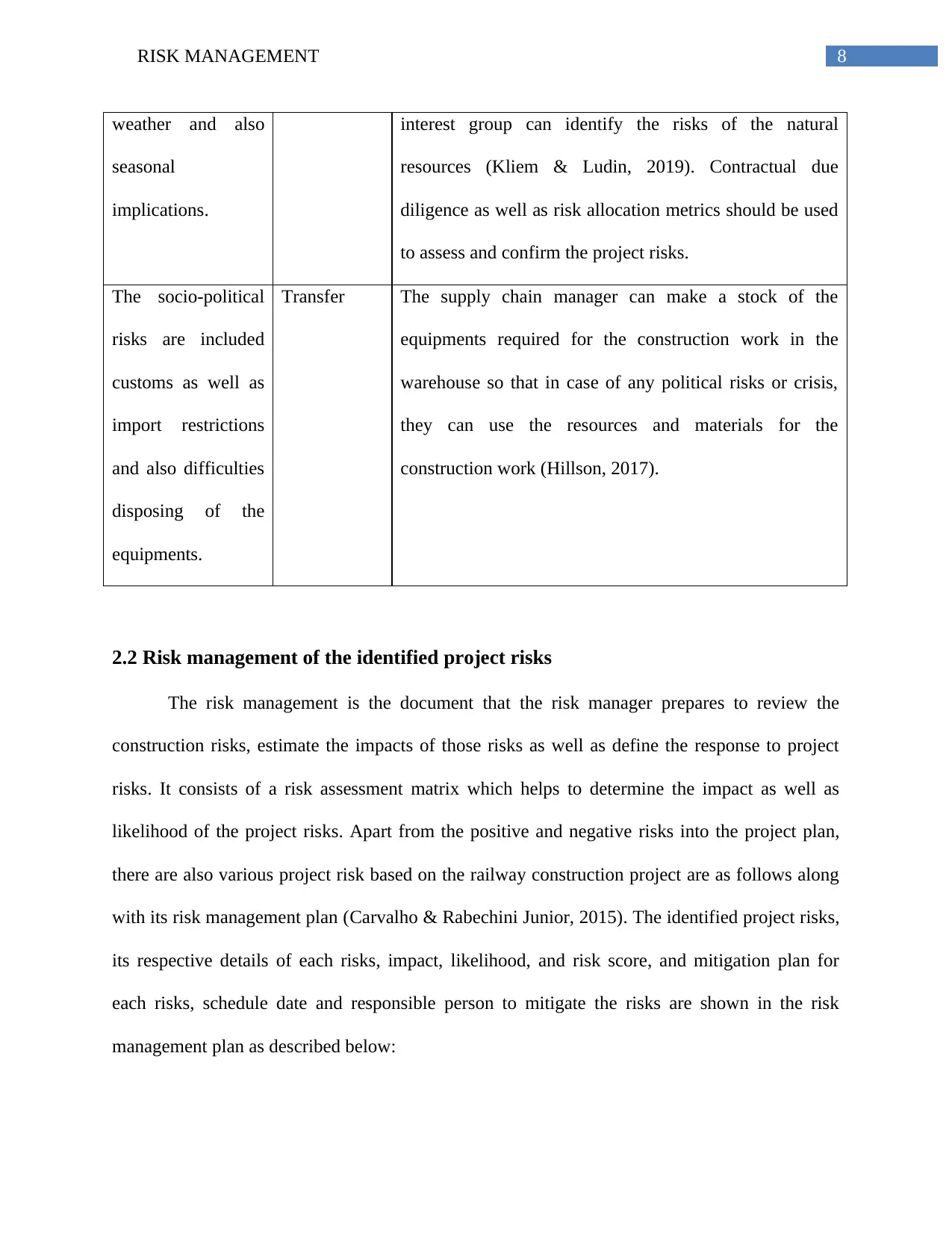
8RISK MANAGEMENT
weather and also
seasonal
implications.
interest group can identify the risks of the natural
resources (Kliem & Ludin, 2019). Contractual due
diligence as well as risk allocation metrics should be used
to assess and confirm the project risks.
The socio-political
risks are included
customs as well as
import restrictions
and also difficulties
disposing of the
equipments.
Transfer The supply chain manager can make a stock of the
equipments required for the construction work in the
warehouse so that in case of any political risks or crisis,
they can use the resources and materials for the
construction work (Hillson, 2017).
2.2 Risk management of the identified project risks
The risk management is the document that the risk manager prepares to review the
construction risks, estimate the impacts of those risks as well as define the response to project
risks. It consists of a risk assessment matrix which helps to determine the impact as well as
likelihood of the project risks. Apart from the positive and negative risks into the project plan,
there are also various project risk based on the railway construction project are as follows along
with its risk management plan (Carvalho & Rabechini Junior, 2015). The identified project risks,
its respective details of each risks, impact, likelihood, and risk score, and mitigation plan for
each risks, schedule date and responsible person to mitigate the risks are shown in the risk
management plan as described below:
weather and also
seasonal
implications.
interest group can identify the risks of the natural
resources (Kliem & Ludin, 2019). Contractual due
diligence as well as risk allocation metrics should be used
to assess and confirm the project risks.
The socio-political
risks are included
customs as well as
import restrictions
and also difficulties
disposing of the
equipments.
Transfer The supply chain manager can make a stock of the
equipments required for the construction work in the
warehouse so that in case of any political risks or crisis,
they can use the resources and materials for the
construction work (Hillson, 2017).
2.2 Risk management of the identified project risks
The risk management is the document that the risk manager prepares to review the
construction risks, estimate the impacts of those risks as well as define the response to project
risks. It consists of a risk assessment matrix which helps to determine the impact as well as
likelihood of the project risks. Apart from the positive and negative risks into the project plan,
there are also various project risk based on the railway construction project are as follows along
with its risk management plan (Carvalho & Rabechini Junior, 2015). The identified project risks,
its respective details of each risks, impact, likelihood, and risk score, and mitigation plan for
each risks, schedule date and responsible person to mitigate the risks are shown in the risk
management plan as described below:
⊘ This is a preview!⊘
Do you want full access?
Subscribe today to unlock all pages.

Trusted by 1+ million students worldwide
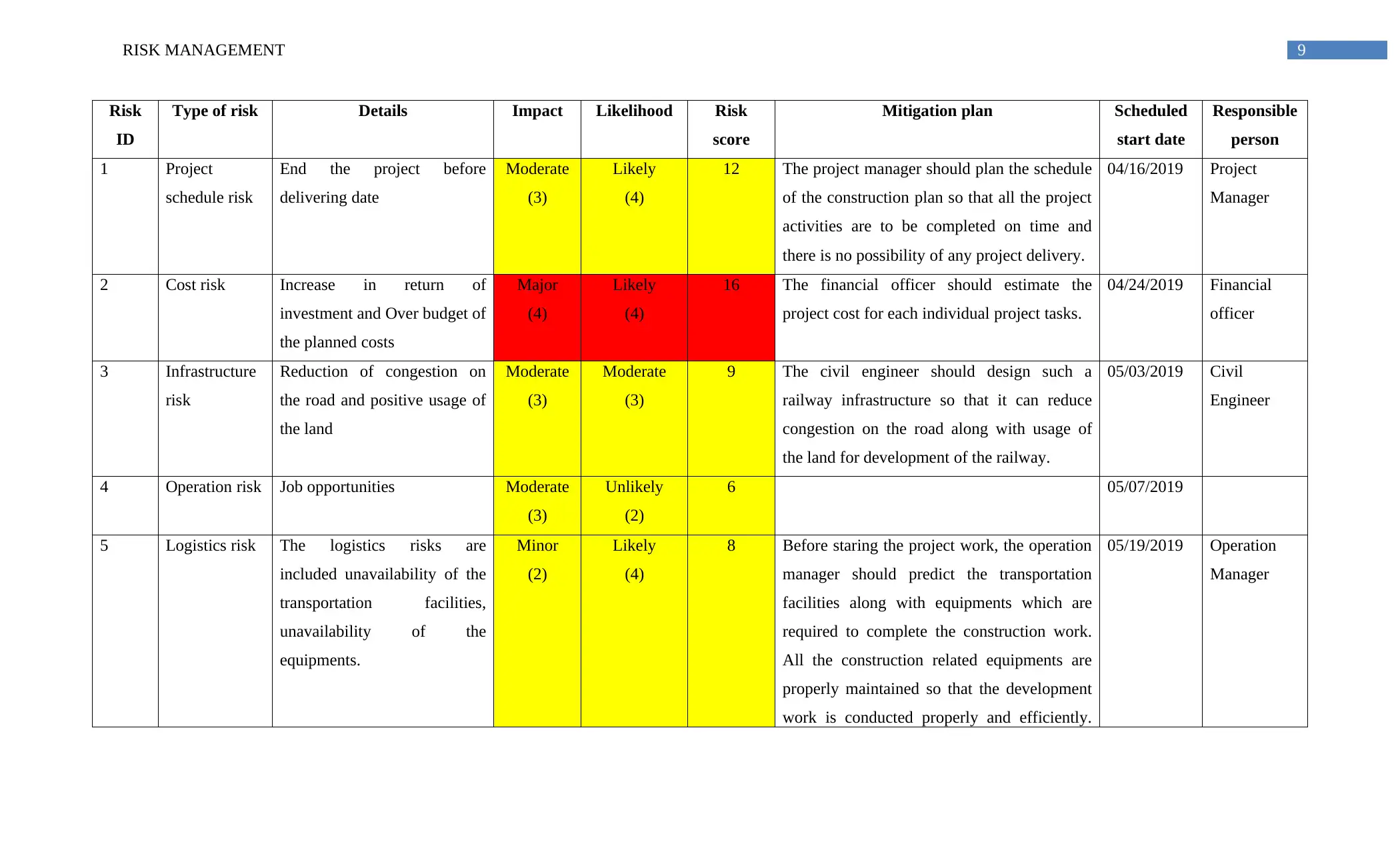
9RISK MANAGEMENT
Risk
ID
Type of risk Details Impact Likelihood Risk
score
Mitigation plan Scheduled
start date
Responsible
person
1 Project
schedule risk
End the project before
delivering date
Moderate
(3)
Likely
(4)
12 The project manager should plan the schedule
of the construction plan so that all the project
activities are to be completed on time and
there is no possibility of any project delivery.
04/16/2019 Project
Manager
2 Cost risk Increase in return of
investment and Over budget of
the planned costs
Major
(4)
Likely
(4)
16 The financial officer should estimate the
project cost for each individual project tasks.
04/24/2019 Financial
officer
3 Infrastructure
risk
Reduction of congestion on
the road and positive usage of
the land
Moderate
(3)
Moderate
(3)
9 The civil engineer should design such a
railway infrastructure so that it can reduce
congestion on the road along with usage of
the land for development of the railway.
05/03/2019 Civil
Engineer
4 Operation risk Job opportunities Moderate
(3)
Unlikely
(2)
6 05/07/2019
5 Logistics risk The logistics risks are
included unavailability of the
transportation facilities,
unavailability of the
equipments.
Minor
(2)
Likely
(4)
8 Before staring the project work, the operation
manager should predict the transportation
facilities along with equipments which are
required to complete the construction work.
All the construction related equipments are
properly maintained so that the development
work is conducted properly and efficiently.
05/19/2019 Operation
Manager
Risk
ID
Type of risk Details Impact Likelihood Risk
score
Mitigation plan Scheduled
start date
Responsible
person
1 Project
schedule risk
End the project before
delivering date
Moderate
(3)
Likely
(4)
12 The project manager should plan the schedule
of the construction plan so that all the project
activities are to be completed on time and
there is no possibility of any project delivery.
04/16/2019 Project
Manager
2 Cost risk Increase in return of
investment and Over budget of
the planned costs
Major
(4)
Likely
(4)
16 The financial officer should estimate the
project cost for each individual project tasks.
04/24/2019 Financial
officer
3 Infrastructure
risk
Reduction of congestion on
the road and positive usage of
the land
Moderate
(3)
Moderate
(3)
9 The civil engineer should design such a
railway infrastructure so that it can reduce
congestion on the road along with usage of
the land for development of the railway.
05/03/2019 Civil
Engineer
4 Operation risk Job opportunities Moderate
(3)
Unlikely
(2)
6 05/07/2019
5 Logistics risk The logistics risks are
included unavailability of the
transportation facilities,
unavailability of the
equipments.
Minor
(2)
Likely
(4)
8 Before staring the project work, the operation
manager should predict the transportation
facilities along with equipments which are
required to complete the construction work.
All the construction related equipments are
properly maintained so that the development
work is conducted properly and efficiently.
05/19/2019 Operation
Manager
Paraphrase This Document
Need a fresh take? Get an instant paraphrase of this document with our AI Paraphraser

10RISK MANAGEMENT
Share forecast as well as demand information
with the trading partners so that it is
responsible for fluctuations of customer’s
demands.
6 Resource risk There is uncertainty of the
project resources and
availability of thee materials,
inadequate site investigation,
incomplete design are the
technical risks.
Moderate
(3)
Likely
(4)
12 There is hiring of resources for the project so
that all the construction work is completed on
time. When one of the team member is not
present in the construction site, then backup
of the project resources are also taken.
06/05/2019 Human
Resource
Manager
7 Environmental
risk
The environmental risks are
included natural disasters,
weather and also seasonal
implications.
Major
(4)
Moderate
(3)
12 The project manager should take help of the
weather forecasting software to forecast if
there are any possibilities of rain, natural
disasters and other seasonal implications on
the site. Then, it provides a bad effect on the
environment which influence on the project
completion date. Contractual due diligence as
well as risk allocation metrics should be used
to assess and confirm the project risks.
06/20/2019 Project
Manager
8 Socio-political
risk
The socio-political risks are
included customs as well as
import restrictions and also
Minor
(2)
Unlikely
(2)
4 Before starting the construction project work
in Western Australia, the project manager and
project owner should require to perform a
06/29/2019 Project
Manager
Share forecast as well as demand information
with the trading partners so that it is
responsible for fluctuations of customer’s
demands.
6 Resource risk There is uncertainty of the
project resources and
availability of thee materials,
inadequate site investigation,
incomplete design are the
technical risks.
Moderate
(3)
Likely
(4)
12 There is hiring of resources for the project so
that all the construction work is completed on
time. When one of the team member is not
present in the construction site, then backup
of the project resources are also taken.
06/05/2019 Human
Resource
Manager
7 Environmental
risk
The environmental risks are
included natural disasters,
weather and also seasonal
implications.
Major
(4)
Moderate
(3)
12 The project manager should take help of the
weather forecasting software to forecast if
there are any possibilities of rain, natural
disasters and other seasonal implications on
the site. Then, it provides a bad effect on the
environment which influence on the project
completion date. Contractual due diligence as
well as risk allocation metrics should be used
to assess and confirm the project risks.
06/20/2019 Project
Manager
8 Socio-political
risk
The socio-political risks are
included customs as well as
import restrictions and also
Minor
(2)
Unlikely
(2)
4 Before starting the construction project work
in Western Australia, the project manager and
project owner should require to perform a
06/29/2019 Project
Manager
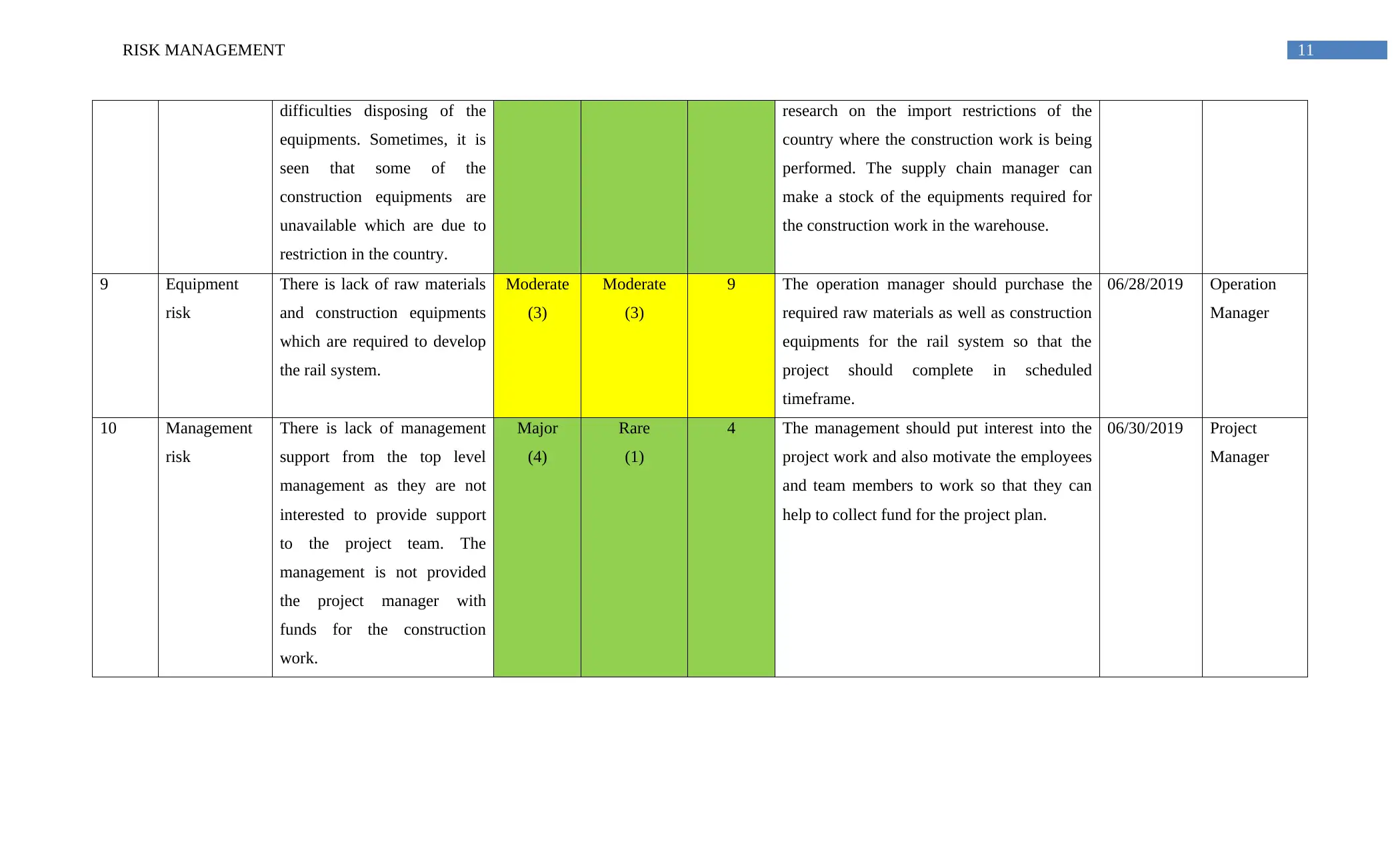
11RISK MANAGEMENT
difficulties disposing of the
equipments. Sometimes, it is
seen that some of the
construction equipments are
unavailable which are due to
restriction in the country.
research on the import restrictions of the
country where the construction work is being
performed. The supply chain manager can
make a stock of the equipments required for
the construction work in the warehouse.
9 Equipment
risk
There is lack of raw materials
and construction equipments
which are required to develop
the rail system.
Moderate
(3)
Moderate
(3)
9 The operation manager should purchase the
required raw materials as well as construction
equipments for the rail system so that the
project should complete in scheduled
timeframe.
06/28/2019 Operation
Manager
10 Management
risk
There is lack of management
support from the top level
management as they are not
interested to provide support
to the project team. The
management is not provided
the project manager with
funds for the construction
work.
Major
(4)
Rare
(1)
4 The management should put interest into the
project work and also motivate the employees
and team members to work so that they can
help to collect fund for the project plan.
06/30/2019 Project
Manager
difficulties disposing of the
equipments. Sometimes, it is
seen that some of the
construction equipments are
unavailable which are due to
restriction in the country.
research on the import restrictions of the
country where the construction work is being
performed. The supply chain manager can
make a stock of the equipments required for
the construction work in the warehouse.
9 Equipment
risk
There is lack of raw materials
and construction equipments
which are required to develop
the rail system.
Moderate
(3)
Moderate
(3)
9 The operation manager should purchase the
required raw materials as well as construction
equipments for the rail system so that the
project should complete in scheduled
timeframe.
06/28/2019 Operation
Manager
10 Management
risk
There is lack of management
support from the top level
management as they are not
interested to provide support
to the project team. The
management is not provided
the project manager with
funds for the construction
work.
Major
(4)
Rare
(1)
4 The management should put interest into the
project work and also motivate the employees
and team members to work so that they can
help to collect fund for the project plan.
06/30/2019 Project
Manager
⊘ This is a preview!⊘
Do you want full access?
Subscribe today to unlock all pages.

Trusted by 1+ million students worldwide
1 out of 18
Related Documents
Your All-in-One AI-Powered Toolkit for Academic Success.
+13062052269
info@desklib.com
Available 24*7 on WhatsApp / Email
![[object Object]](/_next/static/media/star-bottom.7253800d.svg)
Unlock your academic potential
Copyright © 2020–2025 A2Z Services. All Rights Reserved. Developed and managed by ZUCOL.





